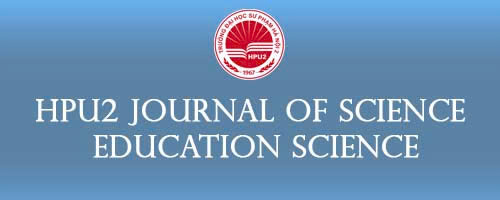The decay of SM-like Higgs boson \(h_0^1 \to Z \gamma\) in a G221 model
DOI:
https://doi.org/10.56764/hpu2.jos.2024.3.2.18-34Abstract
The decay of SM-like Higgs boson \(h_0^1 \to Z \gamma\) in the G221 model which is one of all models beyond the SM (BSM) has been investigated. This decay channel has not been observed experimentally. In the framework, we indicate that new particles predicted by this model may significantly affect the previously mentioned decay channel of the SM-like Higgs boson. We will study the effects of the new heavy-charged boson, the charged Higgs boson was not included previously. We are namely, contributing from the diagram both Higgs boson and charged boson. The calculated results are expressed in terms of Passarino-Veltman functions, the numerical evaluation of which can be obtained using LoopTools. Our numerical investigation presents some details and properties of this decay. These may prove useful for comparison with future experimental results that could be detected.
References
[1] Aad et al., “Observation of a new particle in the search for the Standard Model Higgs boson with the ATLAS detector at the LHC,” Phys. Lett. B, vol. 716, no. 1, pp. 1–29, Sep. 2012, doi: 10.1016/j.physletb.2012.08.020.
[2] Chatrchyan et al., “Observation of a new boson at a mass of 125 GeV with the CMS experiment at the LHC,” Phys. Lett. B, vol. 716, no. 1, pp. 30–61, Sep. 2012, doi: 10.1016/j.physletb.2012.08.021.
[3] Hsieh, K. Schmitz, J. H. Yu, and C. -P. Yuan, “Global analysis of general SU(2) x SU(2) x U(1) models with precision data,” Phys. Rev. D, vol. 82, no. 3, p. 035011, Aug. 2010, doi: 10.1103/PhysRevD.82.035011.
[4] M. Boucenna, A. Celis, J. Fuentes-Martin, A. Vicente, and J. Virto, “Non-abelian gauge extensions for B-decay anomalies,” Phys. Lett. B, vol. 760, pp. 214–219, Sep. 2016, doi: 10.1016/j.physletb.2016.06.067.
[5] T. Hue, A. B. Arbuzov, N. T. K. Ngan, and H. N. Long, “Probing neutrino and Higgs sectors in SU(2)1 × SU(2)2 × U(1)Y model with lepton-flavor non-universality,” Eur. Phys. J. C, vol. 77, no. 5, p. 346, May. 2017, doi: 10.1140/epjc/s10052-017-4866-x.
[6] Aad et al., “Evidence for the Higgs boson decay to a Z boson and a photon at the LHC,” Phys. Rev. Lett., vol. 132, no. 2, p. 021803, Jan. 2024, doi: 10.1103/PhysRevLett.132.021803.
[7] Aad et al., “A search for the Zγ decay mode of the Higgs boson in ρ ρ collisions at √S =13 TeV with the ATLAS detector,” Phys. Lett. B, vol. 809, p. 135754, Otc. 2020, doi: 10.1016/j.physletb.2020.135754.
[8] Tumasyan et al., “Search for Higgs boson decays to a Ζ boson and a photon in proton–proton collisions at √S =13 TeV, ” J. High Energ. Phys., vol. 2023, no. 5, p. 233, May. 2023, doi: 10.1007/jhep05(2023)233.
[9] Bergstrom and G. Hulth, “Induced Higgs couplings to neutral bosons in e+e− collisions,” Nucl. Phys. B, vol. 259, no. 1, pp. 137–155, Sep. 1985, doi: 10.1016/0550-3213(85)90302-5.
[10] J.F. Gunion, G. L. Kane, and J. Wudka, “Search techniques for charged and neutral intermediate-mass Higgs bosons,” Nucl. Phys. B, vol. 299, no. 2, pp. 231–278, Apr. 1988, doi: 10.1016/0550-3213(88)90284-2.
[11] Y. Bardin, P. K. Khristova, and B. M. Vilensky, “Calculation of the Higgs boson decay widths into boson pairs,” Sov. J. Nucl. Phys., vol. 54, pp. 833–844, Mar. 1991, JINR-P2-91-140.
[12] Djouadi, V. Driesen, W. Hollik, and A. Kraft, “The Higgs-photon-Z boson coupling revisited,” Eur. Phys. J. C, vol. 1, no. 1, pp. 163–175, Mar. 1998, doi: 10.1007/BF01245806.
[13] F. Gunion, H. E. Haber, G. Kane, and D. Sally, Eds. The Higgs hunter’s guide. 1st ed. Boca Raton: CRS Press, 2018. doi: 10.1201/9780429496448.
[14] The LHC Higgs Cross Section Working Group, S. Heinemeier, C. Mariotti, G. Passarino, R. Tanaka, Eds. Handbook of LHC Higgs cross sections: 3. Higgs properties. Geneva, Switzerland: CERN Publishing, 2013, doi: 10.5170/CERN-2013-004.
[15] LHC Higgs Cross Section Working Group, D. de Florian, C. Grojean, F. Maltoni, C. Mariotti, A. Nikitenko, M. Pieri, P. Savard, M. Schumacher, R. Tanaka, Eds. Handbook of LHC Higgs cross sections: 4. Deciphering the nature of the Higgs sector (CERN Yellow Reports: Monographs). Geneva, Switzerland: CERN Publishing, 2017, doi: 10.23731/CYRM-2017-002.
[16] T. Hue, A.B. Arbuzov, T.T. Hong, T. Phong Nguyen, D.T. Si, and H.N. Long, “General one-loop formulas for decay h → Z γ,” Eur. Phys. J. C, vol. 78, no. 11, p. 885, Oct. 2018, doi: 10.1140/epjc/s10052-018-6349-0.
[17] C. Pati and A. Salam, “Erratum: Lepton number as the fourth ‘color’,” Phys. Rev. D, vol. 11, no. 3, pp. 703–703, Feb. 1975, doi: 10.1103/PhysRevD.11.703.2.
[18] N. Mohapatra and J. C. Pati, “‘Natural” left-right symmetry,” Phys. Rev. D, vol. 11, no. 9, pp. 2558–2561, May 1975, doi: 10.1103/PhysRevD.11.2558.
[19] N. Mohapatra and J. C. Pati, “Left-right gauge symmetry and an ‘isoconjugate’ model of CP violation,” Phys. Rev. D, vol. 11, no. 3, pp. 566–571, Feb. 1975, doi: 10.1103/PhysRevD.11.566.
[20] G. Senjanovic and R. N. Mohapatra, “Exact left-right symmetry and spontaneous violation of parity,” Phys. Rev. D, vol. 12, no. 5, pp. 1502–1505, Sep. 1975, doi: 10.1103/PhysRevD.12.1502.
[21] N. Mohapatra and P. B. Pal, “Natural seesaw mechanism, eV-keV-MeV-type neutrino spectrum, and cosmology,” Phys. Rev. D, vol. 38, no. 7, pp. 2226–2230, Oct. 1988, doi: 10.1103/PhysRevD.38.2226.
[22] Senjanović, “Spontaneous breakdown of parity in a class of gauge theories,” Nucl. Phys. B, vol. 153, pp. 334–364, Jan. 1979, doi: 10.1016/0550-3213(79)90604-7.
[23] Singer, J. W. F. Valle, and J. Schechter, “Canonical neutral-current predictions from the weak-electromagnetic gauge group SU(3) × U(1),” Phys. Rev. D, vol. 22, no. 3, pp. 738–743, Aug. 1980, doi: 10.1103/PhysRevD.22.738.
[24] W. F. Valle and M. Singer, “Lepton-number violation with quasi-Dirac neutrinos,” Phys. Rev. D, vol. 28, no. 3, pp. 540–545, Aug. 1983, doi: 10.1103/PhysRevD.28.540.
[25] Pisano and V. Pleitez, “SU(3)⊗U(1) model for electroweak interactions,” Phys. Rev. D, vol. 46, no. 1, pp. 410–417, Jul. 1992, doi: 10.1103/PhysRevD.46.410.
[26] H. Frampton, “Chiral dilepton model and the flavor question,” Phys. Rev. Lett., vol. 69, no. 20, pp. 2889–2891, Nov. 1992, doi: 10.1103/PhysRevLett.69.2889.
[27] Foot, H. N. Long, and T. A. Tran, “SU(3)L⊗U(1)N and SU(4)L⊗U(1)N gauge models with right-handed neutrinos,” Phys. Rev. D, vol. 50, no. 1, pp. R34–R38, Jul. 1994, doi: 10.1103/PhysRevD.50.R34.
[28] A. Diaz, R. Martinez, and F. Ochoa, “SU(3)c⊗SU(3)L and U(1)x⊗ models for β arbitrary and families with mirror fermions,” Phys. Rev. D, vol. 72, no. 3, p. 035018, Aug. 2005, doi: 10.1103/PhysRevD.72.035018.
[29] J. Buras, F. De Fazio, J. Girrbach, and M. V. Carlucci, “The anatomy of quark flavour observables in 331 models in the flavour precision era,” J. High Energ. Phys., vol. 2013, no. 2, p. 23, Feb. 2013, doi: 10.1007/jhep02(2013)023.
[30] P. C. R. De Lima and S. A. Dias, “Ward–Takahashi identities for Abelian chiral gauge theories,” Int. J. Mod. Phys. A, vol. 31, no. 11, p. 1650062, Apr. 2016, doi: 10.1142/S0217751X16500627.
[31] -H. Cao and D.-M. Zhang, “Collider phenomenology of the 3-3-1 model,” arXiv (Cornell University), Jan. 2016, doi: 10.48550/arxiv.1611.09337.
[32] X. Yue, Q. Y. Shi and T. Hua, “Vector bileptons and the decays,” Nucl. Phys. B, vol. 876, no. 3, pp. 747–757, Nov. 2013, doi: 10.1016/j.nuclphysb.2013.09.004.
[33] Caetano, C. A. De S Pires, P. S. R. Da Silva, D. Cogollo, and F. S. Queiroz, “Explaining ATLAS and CMS results within the reduced minimal 3-3-1 model,” Eur. Phys. J. C, vol. 73, no. 10, p. 2607, Oct. 2013, doi: 10.1140/epjc/s10052-013-2607-3.
[34] Jungman, M. Kamionkowski, and K. Griest, “Supersymmetric dark matter,” Phys. Rep., vol. 267, no. 5, pp. 195–373, Mar. 1996, doi:10.1016/0370-1573(95)00058-5.
[35] Degrande, K. Hartling, and H. E. Logan, “Erratum: Scalar decays to γγ, Zγ, and Wγ in the Georgi-Machacek model [Phys. Rev. D 96, 075013 (2017)],” Phys. Rev. D, vol. 98, no. 1, Jul. 2018, doi: 10.1103/PhysRevD.98.019901.
[36] S. Antonov and A. G. Drutskoy, “Measurement of Br(H→Zγ)at the 250 GeV ILC,” Jetp Lett., vol. 117, no. 3, pp. 177–183, Jan. 2023, doi: 10.1134/S002136402260330X.
[37] M. Boucenna, A. Celis, J. Fuentes-Martin, A. Vicente, and J. Virto, “Non-abelian gauge extensions for B-decay anomalies,” Phys. Lett. B, vol. 760, pp. 214–219, Sep. 2016, doi: 10.1016/j.physletb.2016.06.067.
[38] Aad et al., “Measurements of the Higgs boson production and decay rates and constraints on its couplings from a combined ATLAS and CMS analysis of the LHC pp collision data at and 8 TeV,” J. High Energ. Phys., vol. 2016, no. 8, p. 45, Aug. 2016, doi: 10.1007/JHEP08(2016)045.
[39] Cepeda et al.,“Report from Working Group 2: Higgs Physics at the HL-LHC and HE-LHC,” in Physics of the HL-LHC, and Perspectives at the HE-LHC (CERN Yellow Rep. Monogr). Geneva, Switzerland: CERN Publishing, Mar. 2019, pp. 221–584, doi: 10.23731/cyrm-2019-007.221.
Downloads
Published
How to Cite
Volume and Issue
Section
Copyright and License
Copyright (c) 2024 Thi-Hong Trinh, Thi-Thin Vu, Thanh-Nha Nguyen Hua

This work is licensed under a Creative Commons Attribution-NonCommercial 4.0 International License.







